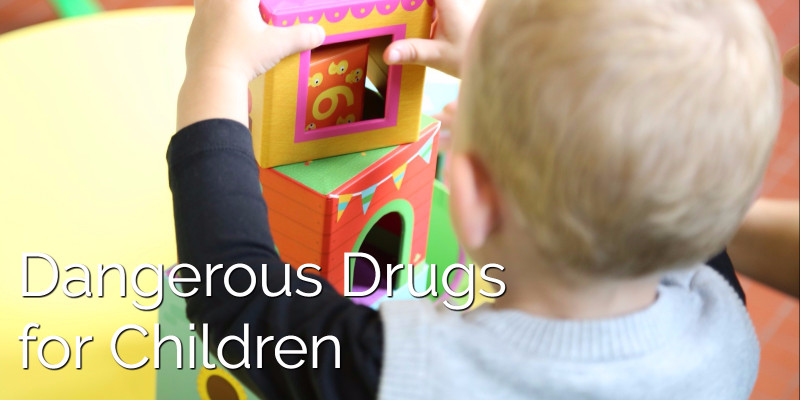All kids get sick. Daycare and play dates alone ensure that common infections and illnesses spread like wildfire. Just when you think you’re over one illness, the next springs up and everyone is sick again! Medication is a necessity for most parents, but understanding dangerous drugs for children is just as important.
It’s sometimes tough for parents to figure out which medications could harm your child. At a time when even talcum powder is subject to lawsuits, it’s important to learn the potential dangers of certain drugs, products, and the common warning signs that your child might be suffering.

Common Health Concerns for Children
First and foremost, when you are worried about your infant or toddler, call your health professional immediately. No amount of online research can provide rapid, accurate advice as well as a qualified pediatrician. Health concerns in older children are just as important to address, but you have additional information to assess severity because the child can better communicate what’s wrong.
Coughs, sniffles, and sneezing are all part and parcel of parenting young children. Cuts and scrapes are as well, but unexplained rashes and bruising should always be more carefully examined. In general, pediatric professionals are moving away from medication like antibiotics to treat less serious infections. Around the turn of the century, concerns were raised that overprescription of such medication would lead to more resistant and damaging bugs. Over-the-counter medications are often substituted as an adequate alternative to treat common childhood illnesses. That being said, the FDA still advises against using cough and cold medicines in children younger than 2 years of age.
Mental wellness is another element of childhood health that parents must carefully monitor. Conditions such as ADHD are now commonly diagnosed, although some medical establishments and health organizations have questioned the accuracy of tests used to assess these conditions. Limited attention span and hyperactive behavior can simply be a byproduct of an engaged, curious child.
Health development milestones in the U.S. suggest that a child should have the ability to remain focused on one activity or topic by age three or four. Once they enter the five to six range, they should be able to focus for around 10-15 minutes. This focus tends to increase more rapidly after that stage, hitting 30 minutes for seven-year-olds and as high as one hour by the time they are nine. However, childhood development
However, childhood development rates vary a lot. Limited focus or high energy levels do not necessarily mean that your child requires treatment for a disorder. While some ADHD medications can be effective, parents are advised to resist the urge to rush to a decision or accept a snap judgment from friends, family, and even medical professionals.
Some drugs come with dangerous side effects that should not be accepted lightly, as we’ll explore in the next section. If you feel uncertain about a recommended medication, take some time to do your research. Don’t hesitate to seek out a second opinion if it will help make the right decision for your child.
Dangerous Drugs for Children
As presented above, ADHD medications provide a cautionary tale about the risks of overprescription. Side effects of drugs like Adderall (dextroamphetamine, amphetamine) and Ritalin (methylphenidate) include trouble getting to sleep, loss of appetite, aches and pains. Their stimulating effect on blood pressure can also lead to developmental problems. At worst, this could present in the form of mania or psychosis. Even at the lower end of the scale, these are not drugs that should be taken lightly.
For children approaching their teens, Risperdal (risperidone) is another concerning drug. Prescribed to treat conditions such as schizophrenia and bi-polar disorder, particularly in adolescence, the drug has been heavily criticized for causing gynecomastia. This is the development of male breasts, as using Risperdal may result in heightened levels of the hormone prolactin.
Other medications that can potentially damage your child’s health, even when used in small doses, include:
- Acetaminophen (found in the familiar brand Tylenol – commonly used but linked to liver damage)
- Oral Hypoglycemics, especially those in medications used to treat diabetes
- Calcium Channel Blockers (often present in meds used to treat blood pressure)
- Quinine (used in heart medications, Placquenil for lupus, and even hair care products like Klorane)
- Lomotil (used to treat diarrhea)
- Camphor (found in many over-the-counter products, including Tiger Balm and vapor sprays/rubs)
- Toxic Alcohols – such as methanol which is found in many paint removers/varnishes and which is metabolized to fomraldehyde and formic acid in the system.
- Theophylline (for asthma, although now less common in North America)
This provides just a glimpse at the potential for dangerous chemicals to get into the hands or bodies of children. Sometimes products that we assume are fine because they don’t affect adults can be extremely dangerous to kids. Always be mindful of the products you use. Learn about them and research potential health concerns online. If you have questions, you can then ask your doctor before making a final decision.
Medications aren’t the only risk in your home, of course. Dangerous drugs for children are worth learning about, but the same applies to potential poisons that exist in other common products.
The American Association of Poison Control Centers (AAPCC) is a useful resource to help parents learn about common household poisons. A good rule of thumb is to keep all medications and chemical products, no matter how benign they seem, up high and out of reach from little hands. If you can secure these products with locked cases or child-proof latches, all the better.
If your child has been experienced adverse health due to a drug, device, or product, you may be entitled to legal compensation. You can access a free case evaluation to learn more about a potential claim.
